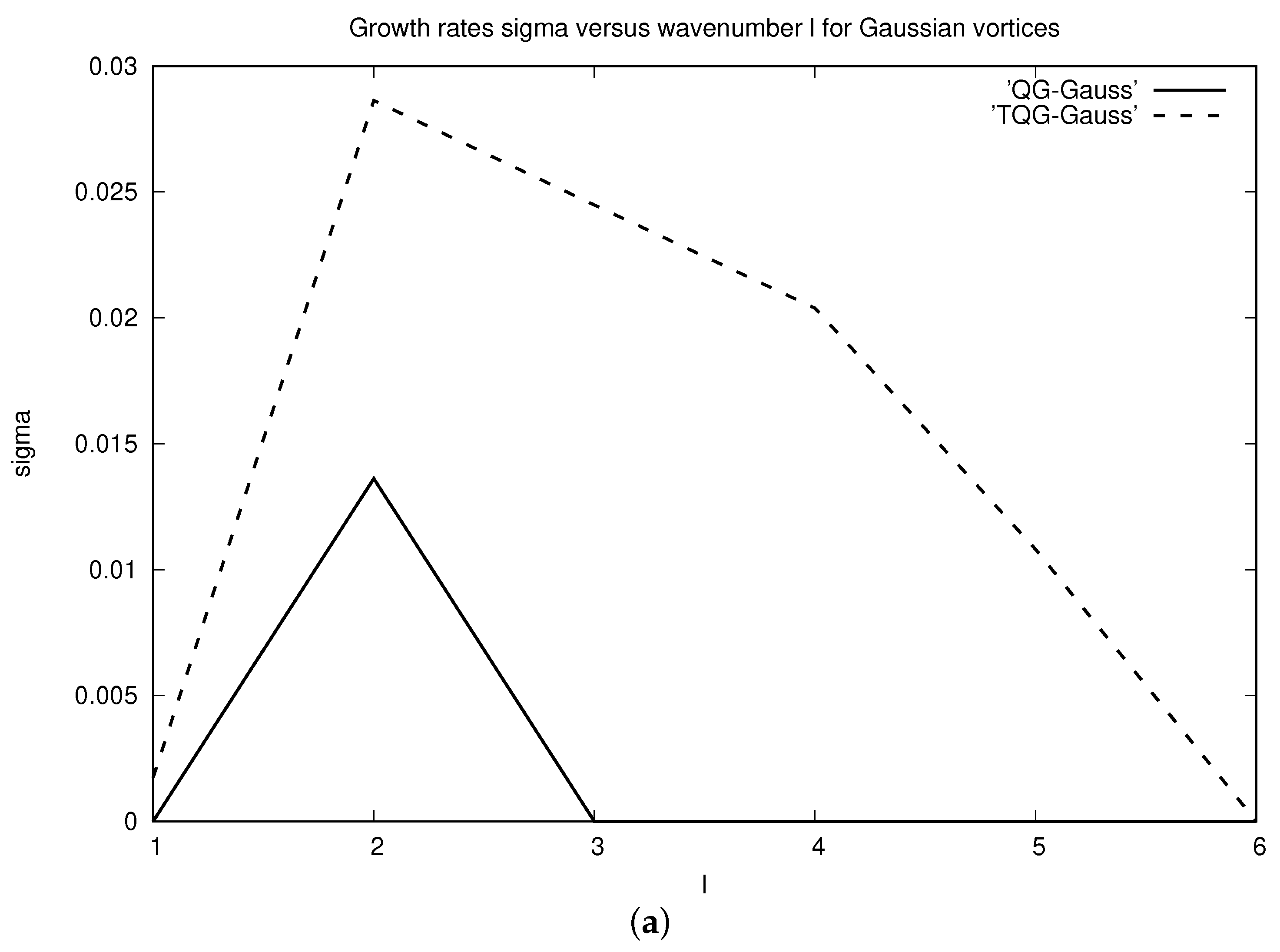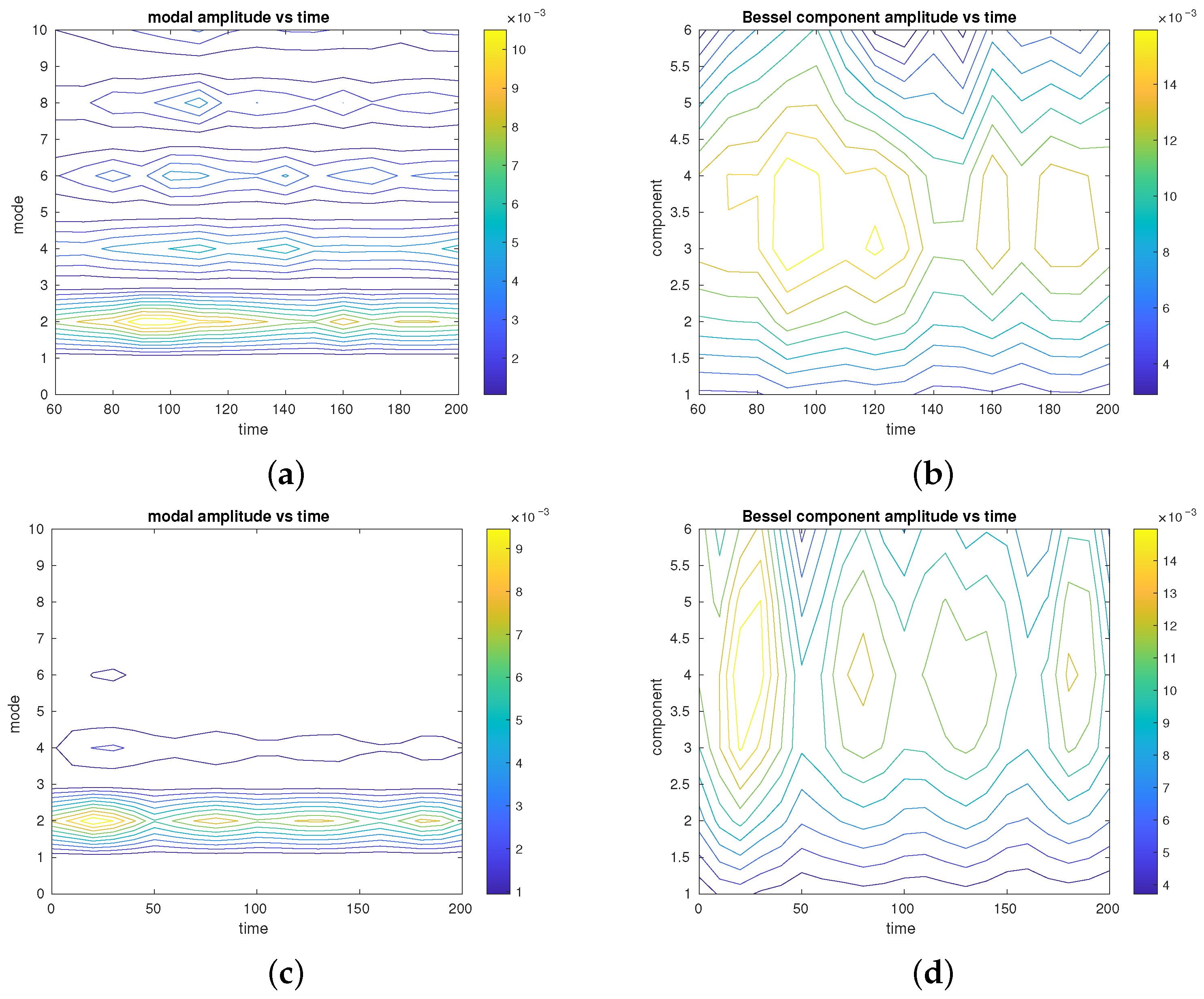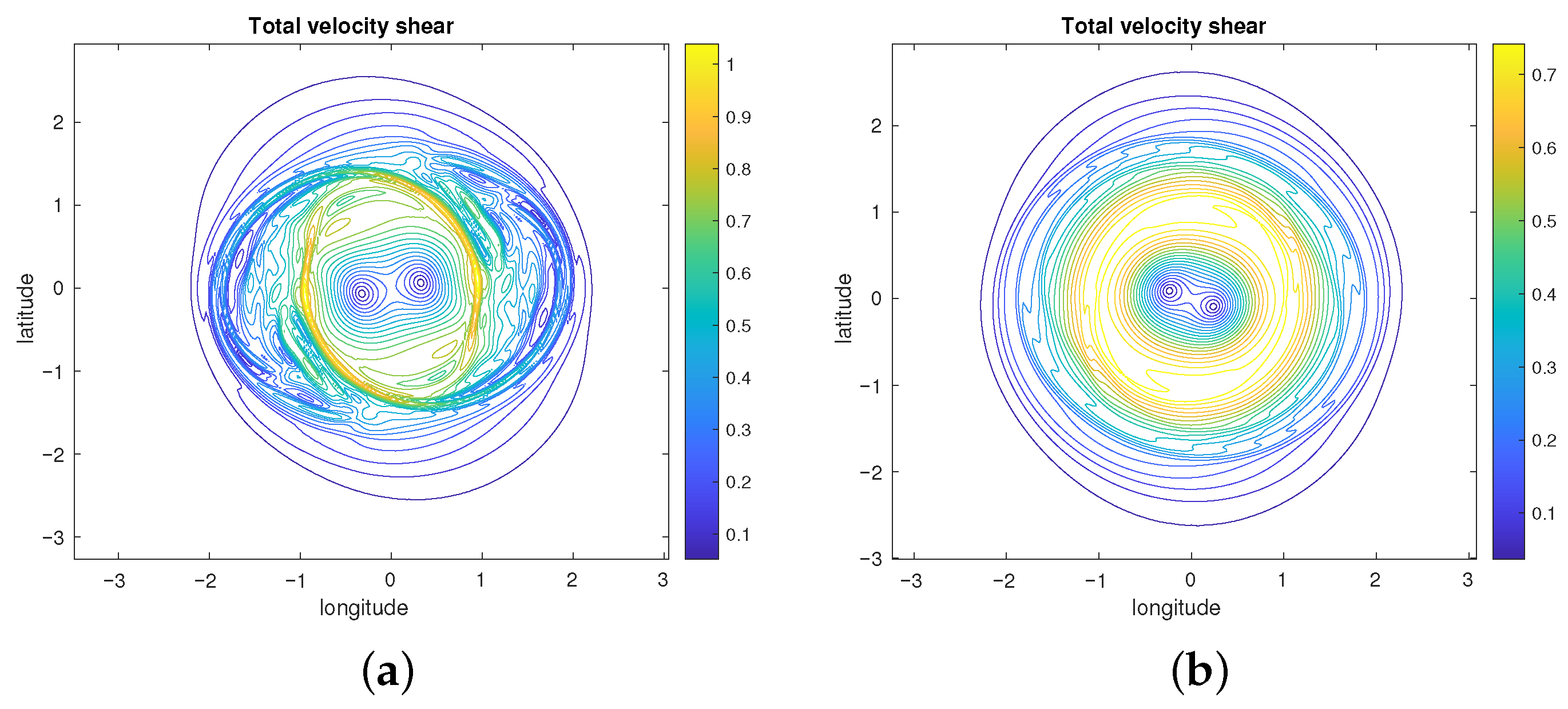Vortex Stability in the Thermal Quasi-Geostrophic Dynamics
Abstract
1. Introduction
2. Model
2.1. Equations
2.1.1. The Thermal Quasi-Geostrophic (TQG) Model
2.1.2. The One-Layer, Reduced Gravity Quasi-Geostrophic (QG) Model
2.1.3. The Two-Dimensional Incompressible (2D) Flow Model
2.2. Flow and Buoyancy Distributions
2.3. Linear and Nonlinear Numerical Models
3. Linear Stability
3.1. A Simple Analytical Solution
3.2. Stability Criterion
3.3. A Second Instability Criterion
3.4. Numerical Analysis of Linear Stability
4. Nonlinear Evolution
4.1. Reference Case
4.2. Parameter Sensitivity
4.2.1. Vorticity Profile Steepness and Relative Intensity of the Mean Buoyancy
4.2.2. Influence of Stratification and of Bottom Topography
4.2.3. Nonlinear Evolutions with Higher Wavenumber Perturbations
5. Discussion
6. Conclusions
Author Contributions
Funding
Data Availability Statement
Acknowledgments
Conflicts of Interest
References
- Ripa, P. General stability conditions for a multi-layer model. J. Fluid Mech. 1991, 222, 119–137. [Google Scholar] [CrossRef]
- Dewar, W.K.; Killworth, P.D. On the Stability of Oceanic Rings. J. Phys. Oceanogr. 1995, 25, 1467–1487. [Google Scholar] [CrossRef]
- Killworth, P.D.; Blundell, J.R.; Dewar, W.K. Primitive Equation Instability of Wide Oceanic Rings. Part I: Linear Theory. J. Phys. Oceanogr. 1997, 27, 941–962. [Google Scholar] [CrossRef]
- Dewar, W.K.; Killworth, P.D.; Blundell, J.R. Primitive-Equation Instability of Wide Oceanic Rings. Part II: Numerical Studies of Ring Stability. J. Phys. Oceanogr. 1999, 29, 1744–1758. [Google Scholar] [CrossRef]
- Baey, J.M.; Carton, X. Vortex multipoles in two-layer rotating shallow-water flows. J. Fluid Mech. 2002, 151–175. [Google Scholar] [CrossRef]
- Ribstein, B.; Gula, J.; Zeitlin, V. (A)geostrophic adjustment of dipolar perturbations, formation of coherent structures and their properties, as follows from high-resolution numerical simulations with rotating shallow water model. Phys. Fluids 2010, 22, 116603. [Google Scholar] [CrossRef]
- Dritschel, D.G.; Scott, R.K.; Reinaud, J.N. The stability of quasi-geostrophic ellipsoidal vortices. J. Fluid Mech. 2005, 536, 401–421. [Google Scholar] [CrossRef]
- Reinaud, J.N.; Carton, X. The stability and the nonlinear evolution of quasi-geostrophic hetons. J. Fluid Mech. 2009, 636, 109–135. [Google Scholar] [CrossRef]
- Reinaud, J.N. Three-dimensional quasi-geostrophic vortex equilibria with m-fold symmetry. J. Fluid Mech. 2019, 863, 32–59. [Google Scholar] [CrossRef]
- Pedlosky, J. The dynamics of a thick fluid layer with a tilted rotation vector. J. Fluid Mech. 2025, 1007, A61. [Google Scholar] [CrossRef]
- Meacham, J.; Pavel, B. Clustering of buoyant tracer in quasi-geostrophic coherent structures. J. Fluid Mech. 2025, 1003, A16. [Google Scholar] [CrossRef]
- Besabe, L.; Girfoglio, M.; Quaini, A.; Rozza, G. Data-driven reduced order modeling of a two-layer quasi-geostrophic ocean model. Results Eng. 2025, 25, 103691. [Google Scholar] [CrossRef]
- Stone, P.H. On non-geostrophic baroclinic stability. J. Atmos. Sci. 1966, 23, 390–400. [Google Scholar] [CrossRef]
- Stone, P.H. Baroclinic instability under non-hydrostatic conditions. J. Fluid Mech. 1971, 45, 659–671. [Google Scholar] [CrossRef]
- Thomas, J. Resonant fast-slow interactions and breakdown of quasi-geostrophy in rotating shallow water. J. Fluid Mech. 2016, 788, 492–520. [Google Scholar] [CrossRef]
- Jim, T. Turbulent wave-balance exchanges in the ocean. Proc. R. Soc. A 2023, 479, 20220565. [Google Scholar]
- Salmon, R. Variational treatment of inertia-gravity waves interacting with a quasi-geostrophic mean flow. J. Fluid Mech. 2016, 809, 502–529. [Google Scholar] [CrossRef]
- Ripa, P. Conservation laws for primitive equations models with inhomogeneous layers. Geophys. Astrophys. Fluid Dyn. 1993, 70, 85–111. [Google Scholar] [CrossRef]
- Beron-Vera, F.J. Multilayer shallow-water model with stratification and shear. Rev. Mex. Fis. 2021, 67, 351–364. [Google Scholar] [CrossRef]
- Lavoie, R. A mesoscale numerical model of lake-effect storms. J. Atmos. Sci. 1972, 29, 1025–1040. [Google Scholar] [CrossRef]
- O’Brien, J.; Reid, R. The non-linear response of a two-layer, baroclinic ocean, to a stationary axially-symmetric hurricane. Part I. Upwelling induced by momentum transfer. J. Atmos. Sci. 1967, 24, 197–207. [Google Scholar] [CrossRef]
- McCreary, J.; Kundu, P.; Molinari, R. A Numerical Investigation of Dynamics, Thermodynamics and Mixed-Layer Processes in the Indian Ocean. Prog. Oceanogr. 1993, 31, 181–244. [Google Scholar] [CrossRef]
- Kurganov, A.; Liu, Y.; Zeitlin, V. Moist-convective thermal rotating shallow-water model. Phys. Fluids 2020, 32, 066601. [Google Scholar] [CrossRef]
- Kurganov, A.; Liu, Y.; Zeitlin, V. A well-balanced central-upwind scheme for the thermal rotating shallow water equations. J. Comput. Phys. 2020, 411, 109414. [Google Scholar] [CrossRef]
- Kurganov, A.; Liu, Y.; Zeitlin, V. Interaction of tropical cyclone-like vortices with sea-surface temperature anomalies and topography in a simple shallow-water atmospheric model. Phys. Fluids 2021, 33, 106606. [Google Scholar] [CrossRef]
- Kurganov, A.; Liu, Y.; Zeitlin, V. Thermal versus isothermal rotating shallow water equations: Comparison of dynamical processes by simulations with a novel well-balanced central-upwind scheme. Geophys. Astrophys. Fluid Dyn. 2021, 115, 125–154. [Google Scholar] [CrossRef]
- Cao, Y.; Kurganov, A.; Liu, Y.; Zeitlin, V. Flux globalization-based well-balanced path-conservative central-upwind scheme for two-dimensional two-layer thermal rotating shallow water equations. J. Comput. Phys. 2024, 515, 113273. [Google Scholar] [CrossRef]
- Rostami, M.; Petri, S.; Fallah, B.; Fazel-Rastgar, F. A novel sea surface evaporation scheme assessed by the thermal rotating shallow water model. Atmos. Sci. Lett. 2025, 26, e1287. [Google Scholar] [CrossRef]
- Rostami, M.; Petri, S.; Fallah, B.; Fazel-Rastgar, F. Aeolus 2.0’s thermal rotating shallow water model: A new paradigm for simulating extreme heatwaves, westerly jet intensification, and more. Phys. Fluids 2025, 37, 016604. [Google Scholar] [CrossRef]
- Ripa, P. Low frequency approximation of a vertically averaged ocean model with thermodynamics. Rev. Mex. Fis. 1996, 42, 117–135. [Google Scholar]
- Warneford, E.S.; Dellar, P.J. The quasi-geostrophic theory of thermal shallow-water equations. J. Fluid Mech. 2013, 723, 374–403. [Google Scholar] [CrossRef]
- Wang, X.; Xu, X. The QG limit of the rotation thermal shallow water equations. J. Differ. Equations 2024, 401, 1–29. [Google Scholar] [CrossRef]
- Crisan, D.; Holm, D.; Luesink, E.; Mensah, R.; Pan, W. Theoretical and computational analysis of the thermal quasi-geostrophic model. J. Nonlinear Sci. 2023, 33, 1–58. [Google Scholar] [CrossRef]
- Crisan, D.; Holm, D.D.; Lang, O.; Mensah, P.R.; Pan, W. Theoretical analysis and numerical approximation for the stochastic thermal quasi-geostrophic model. Stoch. Dyn. 2023, 23, 2350039. [Google Scholar] [CrossRef]
- Beron-Vera, F.J. Nonlinear saturation of thermal instabilities. Phys. Fluids 2021, 33, 036608. [Google Scholar] [CrossRef]
- Ochoa, J.; Sheinbaum, J.; Pavia, E.G. Inhomogeneous Rodons. J. Geophys. Res. C 1998, 103, 24869–24880. [Google Scholar] [CrossRef]
- Lahaye, N.; Larroque, O.; Zeitlin, V. Equatorial modons in thermal rotating shallow water model. J. Fluid Mech. 2024, 984, A58. [Google Scholar] [CrossRef]
- Wang, X.; Xu, X. Thermal instability in rotating shallow-water with horizontal temperature/density gradients. Phys. Fluids 2017, 29, 101702. [Google Scholar]
- Carton, X.J.; Flierl, G.R.; Polvani, L.M. The generation of tripoles from unstable axisymmetric isolated vortex structures. Europhys. Lett. 1989, 9, 339–344. [Google Scholar] [CrossRef]
- Burmasheva, N.; Ershkov, S.; Prosviryakov, E.; Leshchenko, D. Exact Solutions of Navier–Stokes Equations for Quasi-Two-Dimensional Flows with Rayleigh Friction. Fluids 2023, 8, 123. [Google Scholar] [CrossRef]
- Paillet, J.; Le Cann, B.; Serpette, A.; Morel, Y.; Carton, X. Real-time tracking of a Galician Meddy. Geophys. Res. Lett. 1999, 26, 1877–1880. [Google Scholar] [CrossRef]
- Taylor, G.I. Effect of variation in density on the stability of superposed streams of Fluid. Proc. R. Soc. A 1931, 132, 499–523. [Google Scholar]
- Goldstein, S. On the stability of superposed streams of Fluids of different densities. Proc. R. Soc. A 1931, 132, 524–548. [Google Scholar]
- Miles, J.W. On the stability of heterogeneous shear flows. J. Fluid Mech. 1961, 10, 496–508. [Google Scholar] [CrossRef]
- Howard, L.N. Note on a paper of John W. Miles. J. Fluid Mech. 1961, 10, 509–512. [Google Scholar] [CrossRef]
- Gent, P.R.; McWilliams, J.C. The instability of barotropic circular vortices. Geophys. Astrophys. Fluid Dyn. 1986, 35, 209–233. [Google Scholar] [CrossRef]
- Carton, X.J.; McWilliams, J.C. Nonlinear oscillatory evolution of a baroclinically unstable geostrophic vortex. Dyn. Atmos. Oceans 1996, 24, 207–214. [Google Scholar] [CrossRef]
- Trieling, R.R.; Van Heijst, G.J.F.; Kizner, Z. Laboratory experiments on multipolar vortices in a rotating fluid. Phys. Fluids 2010, 22, 1–12. [Google Scholar]
- Carnevale, G.F.; Kloosterziel, R.C. Emergence and evolution of triangular vortices. J. Fluid Mech. 1994, 259, 305–331. [Google Scholar] [CrossRef]
- Kloosterziel, R.C.; Carnevale, G.F. On the evolution and saturation of instabilities of two-dimensional isolated circular vortices. J. Fluid Mech. 1999, 388, 217–257. [Google Scholar] [CrossRef]
- Held, I.; PierreHumbert, R.T.; Garner, S.T.; Swanson, K.L. Surface quasi-geostrophic dynamics. J. Fluid Mech. 1995, 282, 1–20. [Google Scholar] [CrossRef]

















Disclaimer/Publisher’s Note: The statements, opinions and data contained in all publications are solely those of the individual author(s) and contributor(s) and not of MDPI and/or the editor(s). MDPI and/or the editor(s) disclaim responsibility for any injury to people or property resulting from any ideas, methods, instructions or products referred to in the content. |
© 2025 by the authors. Licensee MDPI, Basel, Switzerland. This article is an open access article distributed under the terms and conditions of the Creative Commons Attribution (CC BY) license (https://creativecommons.org/licenses/by/4.0/).
Share and Cite
Carton, X.; Barabinot, Y.; Roullet, G. Vortex Stability in the Thermal Quasi-Geostrophic Dynamics. Fluids 2025, 10, 280. https://doi.org/10.3390/fluids10110280
Carton X, Barabinot Y, Roullet G. Vortex Stability in the Thermal Quasi-Geostrophic Dynamics. Fluids. 2025; 10(11):280. https://doi.org/10.3390/fluids10110280
Chicago/Turabian StyleCarton, Xavier, Yan Barabinot, and Guillaume Roullet. 2025. "Vortex Stability in the Thermal Quasi-Geostrophic Dynamics" Fluids 10, no. 11: 280. https://doi.org/10.3390/fluids10110280
APA StyleCarton, X., Barabinot, Y., & Roullet, G. (2025). Vortex Stability in the Thermal Quasi-Geostrophic Dynamics. Fluids, 10(11), 280. https://doi.org/10.3390/fluids10110280






